Top 10 Office Furniture Trends for 2025
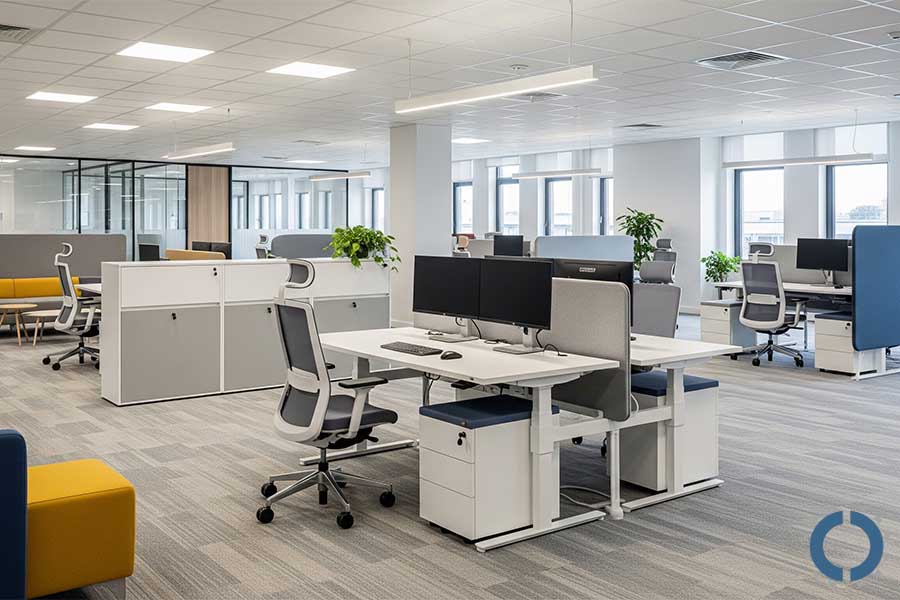
In 2025, business spaces are evolving at an unprecedented pace.
Business owners have shifted away from traditional, formal offices and entered the era of hybrid models, with a special focus on employee well-being, environmental sustainability, and emerging trends.
Now, the question is: What are the office furniture trends for 2025?
Top office furniture trends for 2025 include flexible modular designs, ergonomic seating, biophilic elements (like natural light and plants), sustainable materials, and tech-integrated desks to support hybrid work and employee well-being.
Companies are also seeking solutions that meet the evolving needs of their workforce while creating an inspiring, flexible, and technologically advanced environment.
In this article, we will introduce you to the top 10 office furniture trends that not only transform the office’s look but also significantly enhance the work experience.
If you’re looking to design the workplace of the future, this guide is exactly what you need to read.
Key Drivers Shaping 2025 Office Furniture Trends
- Hybrid Work Models: With hybrid working styles becoming more common, commercial office furniture needs to be flexible and multi-purpose.
This means that it can both meet the need for team collaboration and allow for individual focus.
This directly affects the design of the space and the choice of furniture.
- Employee Well-being and Comfort: As companies prioritize employee well-being, the importance of ergonomic and comfortable furniture has significantly increased.
Chairs with adjustable backs, sit-stand desks, proper lighting, and spaces for mental relaxation have become an integral part of modern offices.
This trend increases job satisfaction and reduces burnout.
- Sustainability and Environmental Consciousness: Consumers and companies are increasingly concerned about the environmental impact of their choices.
Furniture made from recycled materials, responsibly sourced wood (FSC), the use of VOC-free glues and paints, and low-carbon manufacturing processes are top choices.
This trend reflects brands’ commitment to a greener future.
- Technological Advancements: Smart furniture is one of the 2025 office furniture trends and an important development in office design.
Desks with USB-C ports, wireless charging systems, adjustable lighting, integrated cable management, and even ergonomic sensors to detect sitting posture all make the work experience smarter and more efficient.
- Biophilic Design Principles: Incorporating natural elements such as plants, natural light, wood texture, stone, and the sound of water in office design has many psychological benefits.
This approach reduces stress, increases focus, and improves employee morale.
Furniture inspired by or compatible with nature is an influential part of this trend.
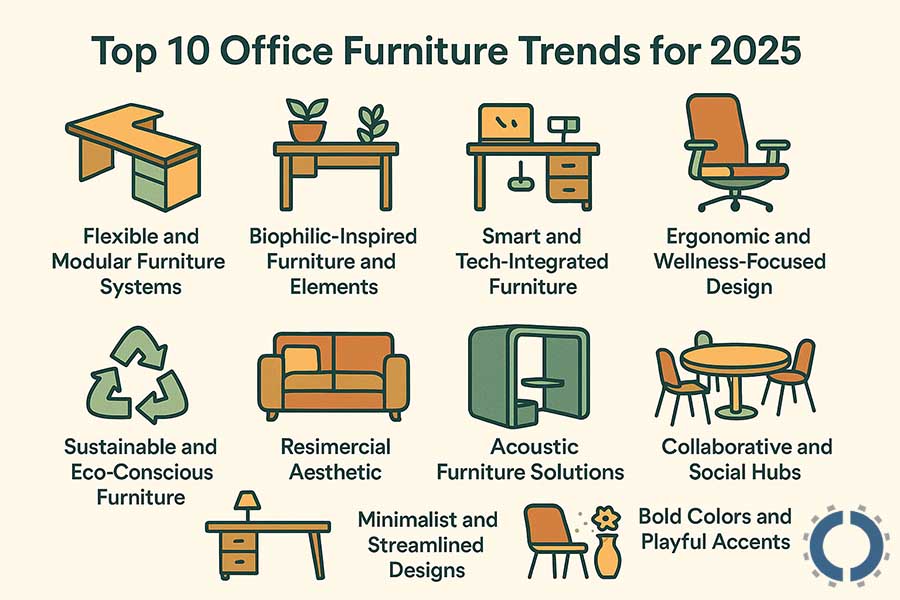
The Leading 10 Office Furniture Trends Transforming Workspaces in 2025
1. Flexible and Modular Furniture Systems
This type of furniture is designed for modern workspaces and aims to provide maximum efficiency, versatility, and optimal use of space.
These systems, which are one of the office furniture trends in 2025, are usually composed of detachable and combinable components that can be easily modified to suit the different needs of the workspace and employees.
- Adaptability: Flexible furniture is designed so that it can be easily changed and rearranged according to the type of work activity.
This type of furniture is very suitable for dynamic and changing workspaces.
For example, desks can quickly switch from individual to group or team mode, or demountable walls can create privacy or open up for meetings.
- Multi-functional Pieces: Multipurpose pieces of furniture are designed that incorporate more than one function, allowing users to use a single piece of furniture for different purposes.
For example, a bench can be used as a place to sit and also have storage space underneath.
- Agile Workstations and Cubicles: Agile workstations and office cubicles are designed to support modern, flexible working practices.
Agile furniture, like hot-desking, is usually lightweight, portable, and has easy access to infrastructure like electricity and internet.
Such designs give employees a greater sense of freedom and choice in choosing their workspace and experience higher productivity.
- Space Optimization: In space-optimized designs, furniture is designed to make the most of the least amount of space.
This is especially important in small offices, shared spaces, or startups.
You Might Also Enjoy: How to Measure an Office Space for Furniture?
2. Biophilic-Inspired Furniture and Elements
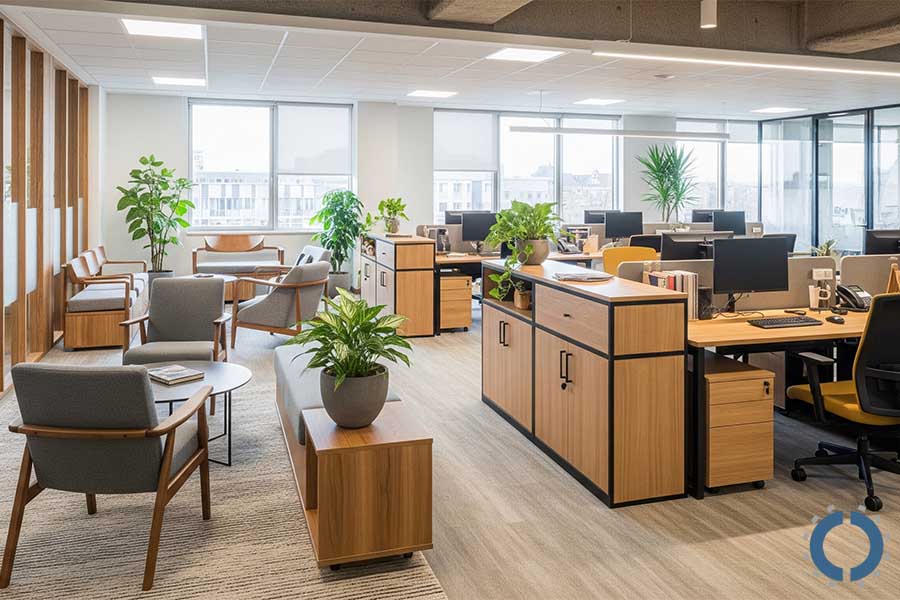
This furniture design style is one of the top office furniture trends, which aims to create a mental and sensory connection between humans and nature in the interior space, and has a great impact on reducing stress, increasing relaxation, and promoting mental health.
- Natural Materials: In biophilic furniture design, the use of natural materials such as wood, bamboo, cork, stone, and rattan is of great importance.
These materials give a warm, organic, and inviting look to the space, and their natural touch and scent also help create a relaxing experience.
Natural materials are often sustainable, renewable, and environmentally friendly as well.
- Organic Shapes: Organic shapes include curved lines, soft forms, and rounded edges, inspired by natural forms such as rocks, trees, leaves, and flowing water.
In furniture, the use of these shapes creates a positive psychological feeling and reduces the hardness of straight and angular lines.
- Integrated Greenery: One of the most important features of biophilic design is the inclusion of living plants in the structure of furniture.
To do this, you can use vases embedded in the table, living green walls, or shelves with special space for table vases.
- Earthy Color Palettes: In biophilic design, the use of colors derived from nature plays an important role.
These colors are commonly used in furniture, wall coverings, fabrics, and interior decorations to indirectly bring a sense of nature into the space.
3. Smart and Tech-Integrated Furniture
This type of furniture is designed with the aim of increasing productivity, comfort, and better human interaction with modern technologies, and is suitable for modern workspaces, smart offices, or educational and creative environments.
- Integrated Power and Charging: One of the key features of smart furniture is the integration of power and charging ports within its structure.
This feature allows users to easily charge their devices without the need for additional cables or searching for an outlet.
- Sensor Technology: The use of sensors in smart furniture is one of the most important developments in workspace design.
- For example, desks that automatically adjust their height or chairs that check body conditions are examples of this technology and are popular office furniture trends.
With the help of these sensors, the temperature, light, and ventilation of the environment can even be adjusted according to the presence of people.
- Connectivity: Today’s smart furniture is designed to easily integrate with smart office systems and digital collaboration tools.
This means the table or chair can be connected to space management platforms, table or meeting room reservation systems, and communication apps.
Some furniture also has Internet of Things (IoT) connectivity and can send information such as time of use, temperature, or ambient light to building management systems.
4. Ergonomic and Wellness-Focused Design
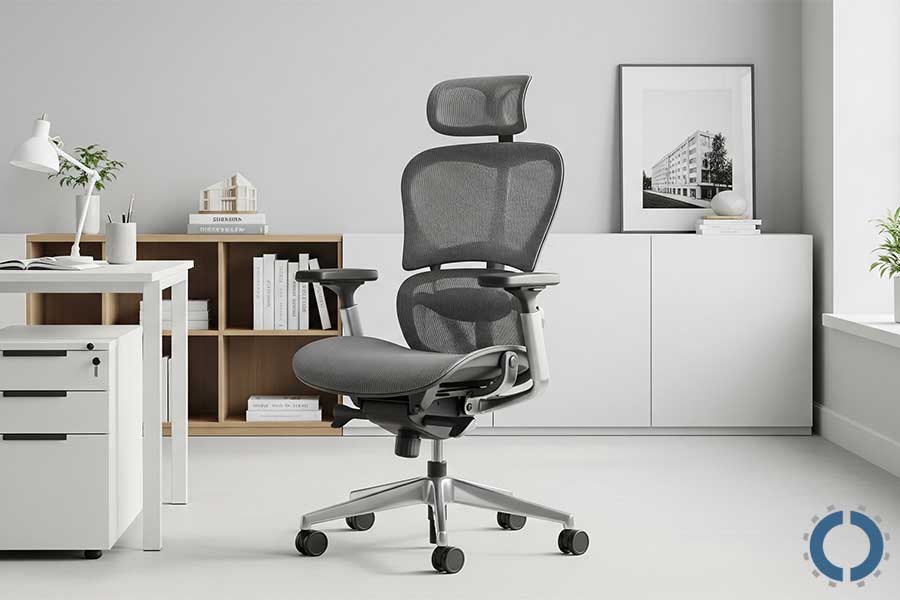
This approach to office furniture design focuses on improving physical health, increasing comfort, and reducing physical strain in the workplace.
- Advanced Ergonomic Office Seating: Another top office furniture trend is ergonomic chairs, which are designed to perfectly match the body’s structure and have dynamic adjustment capabilities.
Features such as adjustable backrest, lumbar support, seat height and angle adjustment, and the use of breathable materials to prevent sweating are among the key points in the design of these chairs.
- Height-Adjustable Workstations: Sit-stand desks allow users to switch between sitting and standing positions throughout the day.
These desks easily change their height, usually with an electric or manual mechanism, and prevent injuries caused by prolonged sitting.
- Active Seating Options: Along with traditional chairs, the use of furniture that encourages movement and dynamism has also become popular.
These include backless stools, balance balls, or chairs with unstable bases that engage the core muscles.
- Focus on Health: In health-centered design, all furniture elements are designed to maintain proper posture, reduce physical strain, and promote the user’s overall well-being.
This includes proper body support, providing the right height and angle for the screen, proper lighting, and using non-allergenic materials.
5. Sustainable and Eco-Conscious Furniture
This approach focuses on designing furniture that causes minimal damage to the environment while still providing high performance and a long lifespan.
For this reason, it is one of the most popular office furniture trends among businesses.
- Recycled and Upcycled Materials: One of the important principles of sustainable furniture design is the use of materials that have been previously used or obtained from industrial waste.
These materials can include recycled plastics, recycled metals, discarded textiles, or reclaimed wood from old buildings.
- Low-VOC Finishes: Volatile chemicals such as VOCs, which are found in common paints, varnishes, and adhesives, can be harmful to human health and the environment.
Sustainable furniture uses paints and coatings that contain no or very low levels of VOCs.
These materials are non-toxic and do not cause indoor air pollution.
- Durability and Longevity: Another principle of sustainability is to design furniture that can be used for years and does not need to be replaced frequently.
The selection of high-quality materials, engineered design, and durable construction makes the furniture resistant to wear and tear, constant use, and environmental damage.
The longer a piece of furniture lasts, the lower its carbon impact in the consumption cycle.
- Circular Economy Principles: The circular economy is a concept that emphasizes designing products for multiple use, repair, remanufacture, and recycling.
In furniture design based on these principles, parts are made in a way that they can be easily disassembled, defective parts replaced, or the entire product recycled at the end of its useful life.
6. Resimercial Aesthetic
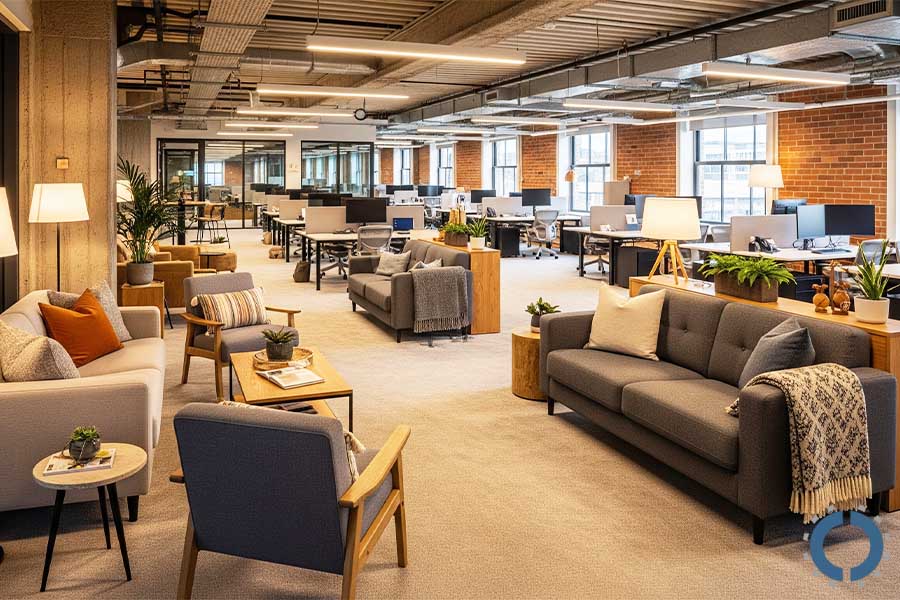
The term Resimercial is a combination of the words Residential and Commercial and refers to a style of interior design that blurs the line between home and workplace.
The goal of this approach is to create workspaces that instill a sense of warmth, comfort, and familiarity with home in the professional environment of the office.
- Blurring Lines: In the Resimercial style, the clear boundary between home and work disappears.
This means that the design is done in such a way that the work environment is both professional and friendly at the same time.
This approach gives employees a greater sense of belonging and comfort, increasing motivation.
- Soft Furnishings: The use of soft furnishings such as comfortable sofas with fabric covers, cushions, rugs, curtains, and decorative accessories in the space plays an important role in creating a homely atmosphere in the workplace.
- Residential Touches: In residential design, spaces such as lobbies, waiting rooms, or informal office areas are arranged to resemble the living room of a home.
These spaces usually feature comfortable furniture, coffee tables, bookshelves, soft lighting, and home decor.
- Warm and Inviting Ambiance: The ultimate design goal of this office furniture trend is to create a space that feels comfortable, relaxing, and inviting.
Unlike traditional offices, which can seem dull or formal, residential spaces use warm colors, natural textures, soft lighting, and comfortable furniture to create an environment where people feel safe and belong.
7. Acoustic Furniture Solutions
Since open-concept businesses have become so popular these days, this type of design aims to reduce noise, increase focus, and improve the sound quality of work or public environments.
- Sound-Absorbing Materials: One of the main methods of controlling sound in a space is to use furniture and panels that have sound-absorbing properties.
These materials include acoustic fabrics, special foams, and soft, thick surfaces such as fabric-covered seats or felt-covered partitions.
By absorbing sound waves, these elements prevent sound from reflecting and creating echoes in the environment.
- Privacy Pods and Booths: One of the most effective solutions for maintaining sound privacy is to use privacy pods or small, insulated rooms.
They often have acoustic walls and can be designed as standing or sitting, single or multi-person.
These pods help reduce noise interference in open spaces, allowing for private conversations without being disturbed or revealing information.
- Zoned Acoustics: In this approach, the space is divided into sections with different sound levels so that each activity can be carried out in an environment tailored to its acoustic needs.
This acoustic separation allows users to choose the appropriate space for their activities according to their needs.
You Might Also Enjoy: Where to Donate Office Furniture in Houston [2025 Guide]
8. Collaborative and Social Hubs
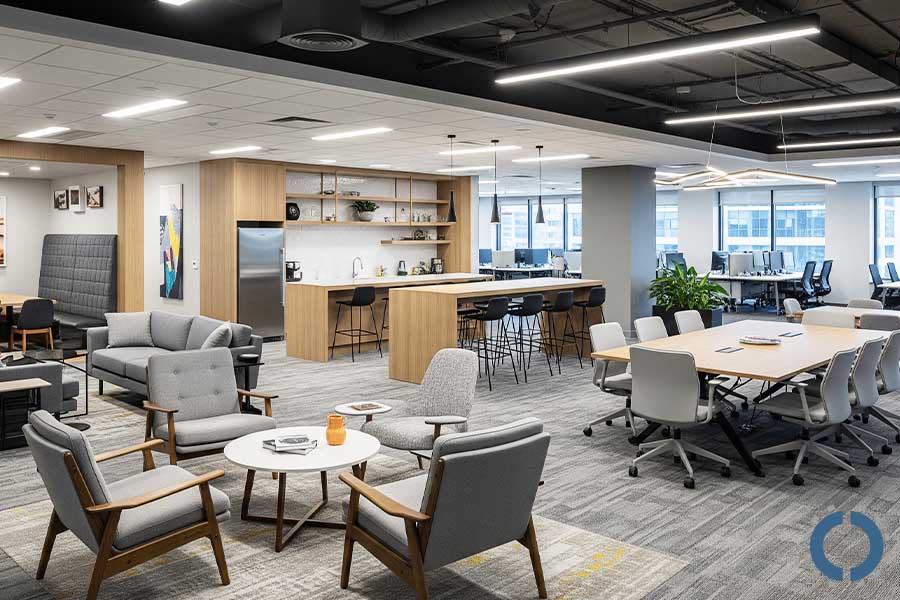
These furniture and spaces in modern office design have become one of the office furniture trends in 2025 due to enhancing interaction between employees, creating natural collaboration opportunities, and building organizational culture.
- Lounge Seating: This type of furniture is usually placed in open areas or lounge areas and is designed for informal conversations, friendly conversations, or short breaks.
- Large Conference Tables: Large tables are designed for team meetings, brainstorming, or multi-person meetings.
These tables are usually located in the center of common spaces or meeting rooms and are constructed so that all members have a direct view of each other.
- Mobile Whiteboards and Displays: To keep team interaction dynamic and unrestricted, using portable whiteboards, magnetic boards, or digital displays on wheels is very effective.
These tools make the work environment more flexible and promote creativity and rapid collaboration.
- Community Kitchen or Cafe Furniture: The furniture in these spaces includes high tables, bar stools, communal benches, and tables that bring people together for informal interactions and casual conversations.
9. Minimalist and Streamlined Designs
The goal of designing office furniture with this style is to create calm, orderly, and focused environments.
- Clean Lines: Minimalist furniture has simple forms and no extra decorations.
Clean lines in the design of tables, chairs, shelves, and other elements create a neat, professional, and understated look.
- Integrated Storage: In minimalist office furniture design, solutions are used to hide clutter and unnecessary equipment.
Shelves, drawers, or cabinets built into the structure of a table or wall are examples of these solutions.
- Functional Simplicity: In this style, the main focus is on basic and functional features.
This means that each furniture element only has features that are used, and any unnecessary decorations or features are avoided.
- Neutral Color Palettes: Common colors in minimalist design are usually neutral colors such as white, gray, beige, black, or light brown.
These colors convey a sense of calm, simplicity, and elegance.
10. Bold Colors and Playful Accents
This approach to office furniture design brings energy, personality, and creativity to workspaces through the clever use of vibrant colors and striking patterns.
- Strategic Color Use: Bold colors are usually used on office furniture such as chairs, walls, vases, or decorative elements, while the rest of the space is composed of neutral or calm colors.
- Pattern Play: Geometric patterns, abstract designs, or subtle textures can enter the space through chair covers, wall fabrics, partitions, or rugs.
- Balancing Act: Although it is important to use bold colors and creative details when choosing office furniture, the key to success in this style is to balance it with simple elements and basic colors such as white, gray, or wood.
- Reflecting Brand Identity: The colors and patterns used in furniture and decor can reflect a brand’s culture, values, and visual identity.
Integrating office furniture with brand personality creates both coherence and a positive psychological impact on employees and clients.
Conclusion
Overall, emerging trends in office furniture design indicate that the workspace is no longer seen as just a place to perform daily tasks but as a platform for creativity, well-being, interaction, and human productivity.
New office furniture trends in 2025 not only meet today’s needs but also create a flexible and adaptable future for workplaces.
Looking to the future, office space design and office furniture will move towards greater compatibility with flexible, technology-driven, and health-oriented work models.
Ultimately, companies need to think beyond aesthetics and invest in furniture that not only aligns with their brand identity but also supports employee well-being, engagement, and performance.

John Ofield is the owner of Collaborative Office Interiors. Houston’s trusted source for modern and commercial office furniture, office cubicles, demountable walls, office desks and tables, and complete workspace solutions. With more than 40 years of experience, he combines deep product knowledge with hands-on space-planning expertise to create ergonomic, productivity-focused work environments for businesses across Southeast Texas.


